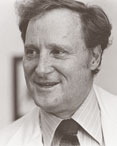 |
A Cancer Prevention Clue:
Zebrafish Excel at Repairing Their Own DNA
 |
|
 |
Resources:
|
 |
|
The late Lawrence Grossman, former MBL Corporation member and distinguished service professor at the Bloomberg School of Public Health, Johns Hopkins University. Photo courtesy of JHSPH.
|
|
 |
|
MBL Corporation member Raquel Sussman
|
|
Regularly and unavoidably, our bodies are exposed to carcinogens such as UV sunlight and environmental chemicals in our food and water. Yet we are not defenseless. Through a vigilant system of rescue enzymes, our cells continuously repair the damage done to their DNA by environmental toxins or other agents. Cells that fail to do so eventually die or become cancerous.
The link between cancer risk and DNA repair capacity was first described by the late Lawrence Grossman, a former MBL Corporation member and Johns Hopkins professor, and his co-workers. To both honor and build upon Grossman’s work, MBL Corporation member Raquel Sussman reports on the remarkable DNA repair capacity of zebrafish in a recent issue of Proceedings of the National Academy of Sciences (PNAS).
Why zebrafish? Over the past two decades, zebrafish (Danio rerio) have emerged as a top model system for studying normal development and birth defects in vertebrates. Through the use of genetic screens—in which researchers induce DNA mutations in an organism and then correlate them to developmental abnormalities—more than 500 mutant types of zebrafish have been identified. Many of these are now being used to model human diseases, including cancer, and to test medical therapies.
In her PNAS paper, Sussman shows that wild-type zebrafish—a 2-inch-long, freshwater fish that frequently populates home aquaria—are very efficient at repairing lesions in their DNA, more so than humans. The implications? First, researchers who use zebrafish as a sentinel to detect carcinogens in water should realize it may not be the most sensitive organism—unless they knock out its DNA repair enzymes, many of which Grossman characterized. Secondly, Sussman says, “there must be more systems in the zebrafish for repairing DNA than we find in humans.” Thus, it could be a good model system for uncovering new parameters in cancer prevention.
“Grossman was a pioneer in his field,” says Sussman. To perform her zebrafish study, she used an assay Grossman introduced in 1995 that allows one to quantify the DNA repair capacity of the T-lymphocytes of individual people. “This allowed him to address the epidemiology of cancer as it relates to DNA repair,” she says. The assay, called host-cell reactivation assay, has demonstrated a correlation between impaired DNA repair capacity and a higher risk of skin, breast, and prostrate cancers.
“Another important fact that Grossman established is that DNA repair capacity decreases with age, which explains why cancer is primarily a disease of older people,” Sussman says. Grossman showed that the human population has a normal distribution of DNA repair capacity. “What this means,” says Sussman, “is that about 30% of us have such a low capacity to heal the damage, that even a chest X-ray can induce leukemia or other cancers. Medical and dental practice—taking whole mouth X-ray pictures every year whether you need it or not—have not yet addressed these scientific facts.”
Sussman is the first to apply Grossman’s host-cell reactivation assay to experimental animals. “We are still uncovering more and more uses for this assay, especially if we use it in animals and bacteria,” she says.
The MBL is a leading international, independent, nonprofit institution dedicated to discovery and to improving the human condition through creative research and education in the biological, biomedical and environmental sciences. Founded in 1888 as the Marine Biological Laboratory, the MBL is the oldest private marine laboratory in the Western Hemisphere. For more information, visit www.MBL.edu
|